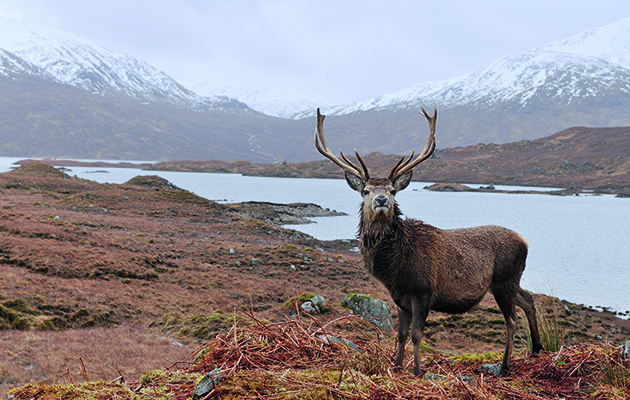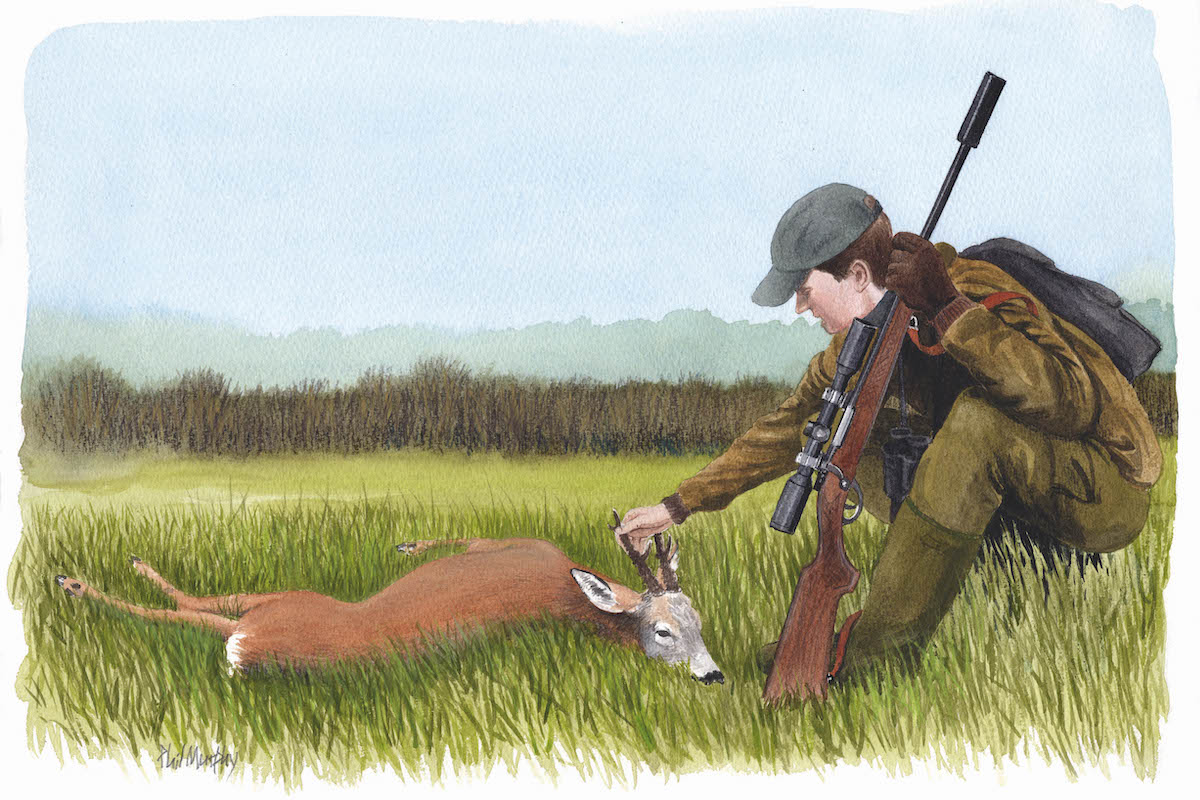In praise of the Scottish red deer
The Scottish red deer is thought to be indigenous, having been established in Britain since the last ice age. But what sets it apart from its relatives on other continents? Iain Watson goes native

The Scottish red deer, Cervus elaphus scoticus, is in a league of its own
There can be a bit of head scratching as to what is a native Scottish red deer. It is not entirely straightforward and over the years has been further confused by man’s interference, “improving” the local population by adding genes to provide sport and in doing so diluting the purity of the native animal. Plus, of course, red deer have also interbred with near relatives, such as the sika, clouding the issue still further. Red deer, as well as the roe, are considered to be indigenous, having been established in Britain since the last ice age. Along with the remains of the Irish elk, the bones and antlers of red deer can be found in clay and gravel deposits, illustrating how it has changed and shrunk over the millennia.
The fourth-largest of the living deer species, it has a wide distribution across continents, present from south-western Asia through to Europe and into North Africa, where the Barbary stag (a subspecies of red deer) is the only deer species found on that continent.
More recently, red deer have also been distributed over huge distances by man. Populations are established, and are self-sustaining, as far away as South America, Australia and New Zealand.
Add to this its popularity as a farmed animal, and its good looks as an amenity species in parks, and it is easy to understand how its genes have become mixed and diluted. The variation in its size and conformation illustrate how the species adapts to local environments and conditions, from hot to cold and from wet to dry.

This red parkland deer’s huge head suggest that is is possibly a hybrid
Scottish red deer are hard to identify
As far as subspecies go, the Scottish red deer is undoubtedly at the small end of the scale. The Monarch of the Glen is no match for the mighty maral, whose skull and antlers can weigh more than 18kg, or the Carpathian stag, with a body weight of up to 500kg. Genetically isolated from these main European populations, the Scottish red has had to contend with and adapt to changing conditions over the centuries, particularly to climate and land use.
After a long period of range contraction, when it was forced farther north and west, the Scottish red deer population greatly expanded in the past 60 years or so, partly as a result of commercial afforestation and the shelter it offers, as well as changes in sheep stocking densities and reduced competition for available grazing. This spread has allowed it to re-establish itself well below the Highland fault line into west central Scotland and farther south.
South of the border, there have been native red deer in the Lake District since time immemorial. From remains left behind, it would seem that they were widespread across north-western England during the Roman occupation of the country, while recognised deer forests in these areas survived into Elizabethan times. Farther south, localised populations have resulted from escapes from deer parks, deliberate releases and the introduction of animals to supplement numbers in areas where deer hunting was practised. These southern animals are thought to derive from the larger subspecies found on mainland Europe and park stock, bigger animals often sporting a different antler conformation.
In theory, then, it should be a simple matter to differentiate between the two types. But in practice this is not always so. Deer farmers in the south have taken advantage of the ready source of breeding females from the wild herds in the Scottish Highlands and run these with large park and European stags. Forest owners in the north have imported and liberated both sexes from parks in an effort to improve trophy size and quality. The outcome has been European types that show traces of native blood, and Scottish types with characteristics and genes of their European cousins.

Fossils show that red deer have been in Britain since the ice age
Scottish red deer are a bit different from European counterparts
When it comes to looks and lifestyle Scottish red deer are a bit different from their European counterparts. They are smaller in frame size and in summer, lighter in colour. Scottish animals have a distinct border to the yellowish rump patch and the face and neck tend to be greyer in colour than continental animals. By autumn as the rut approaches, many will display a shaggy neck coat.
While the iconic image is of a 12-pointed Royal stag, for most of us who grass a stag the reality is more likely to be an eight- to 10-point animal either lacking in top points and/or missing bez tines (the part of the antler that erupts from the beam above the brow points). Like other species of deer, Scottish stags improve with age. Genetics mean that 12 points might not appear if animals are left, but heads will certainly grow and lengthen. For those who stalk in Scotland, the reality is that the average age of the national stag herd is at best half of the average life expectancy, so somewhere around four to five years old, and immature animals mean immature heads. Scottish hinds in general breed when they are three years old and produce a single calf. Adult hinds that miss a breeding season are referred to as “yeld”, while those too young to breed who continue to consort with their mothers are known as “followers”. The sexes live apart for most of the year, coming together for the autumn rut.
Though Scottish deer have made use of changes in the landscape, particularly afforestation, they remain predominantly animals of the open hill. Given upland weather conditions, this offers an insight into why they are smaller and more hairy than other subspecies. The genes are there but the environmental conditions, the lack of shelter and quality of feeding, for example, mitigate against the animal achieving its full potential.
This is in contrast to what can be attained by the same animals in captivity, or those in a kinder environment such as the Scottish deer exported to New Zealand, which have not only thrived but have achieved a size and head development unknown at home. The late Bruce Banwell, who was a great supporter of deer in New Zealand, maintained that those in the southern hemisphere amounted to the only pure examples of the species remaining. Rather like roe, our best deer often come from specific areas. The top Scottish reds often come from west coast islands with Arran, Islay and North and South Uist leading the way.

Key points for stag selection
For stalkers, an autumn trip to stalk stags can be a highlight of a lifetime. For most it is taken in the company of a professional, so it is important to realise that the selection of the target animal is therefore a matter for the professional and will be based on a number of factors. These will include the estate’s cull plans and targets, the availability of animals during that particular season and day, the weather conditions and the ability of the guest. The location of the animals on the hill and the ease or otherwise of recovery of the stag after the shot are also often factors of considerable importance.
When considering the age of a stag, the body conformation and antler development of the animal need to be assessed. Mature red stags will show a thickening of the neck and a rounded, full development of the haunches and body.
On the hill there are two types of mature stags to pay attention to, and which professional stalkers will always have on their target list: switches and hummels. Switches carry long, unbranched antlers, sometimes with brow points present, which in combat during the rut can be lethal to competitors. Hummels lack antlers and are often large-bodied; the condition is thought to be hereditary and they are not welcome in most deer forests.

Comparative sizes. From left to right: Red deer, Irish elk and sika
Red deer sub species listed by the CIC (International Council for Game and Wildlife Conservation)
Swedish red deer – Cervus elaphus elaphus
Norwegian red deer – Cervus elaphus atlanticus
Central European red deer – Cervus elaphus hippelaphus
Carpathian red deer – Cervus elaphus montanus
Scottish red deer – Cervus elaphus scoticus
Spanish/Iberian red deer -Cervus elaphus hispanicus
Corsican red deer – Cervus elaphus corsicanus
North African red deer – Cervus elaphus barbarus
Red deer (introduced)* – Cervus elaphus hippelaphus (* This designation used for park and other types that have become feral in the wild).
Red deer stalking seasons
Scotland – Stags: 1 July – 20 Oct Hinds: 21 Oct – 15 Feb
England & Wales – Stags: 1 Aug – 30 April Hinds: 1 Nov – 31 Mar
Northern Ireland – Stags: 1 Aug-30 April Hinds: 1 Nov – 28 Feb








